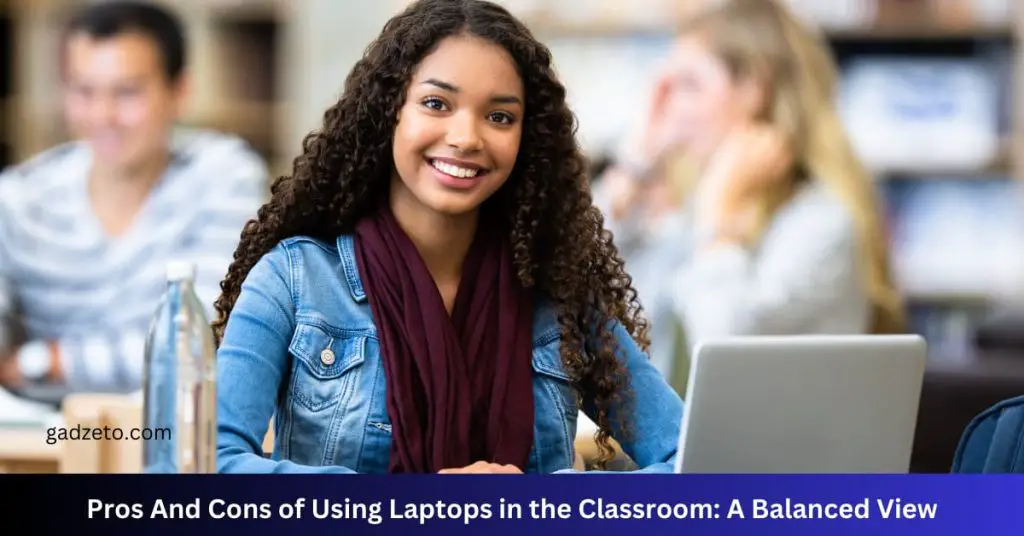Pros of laptops in the classroom include enhanced access to information and interactive learning, while cons involve potential distractions and the risk of promoting inequality. Laptops integrate technology with education, fostering digital skills and offering a vast knowledge base at students’ fingertips.
The debate over laptops in the classroom centers around their dual role as tools for engagement and potential sources of distraction. They have revolutionized the way educators teach and students learn, providing real-time access to up-to-date information and digital resources.
Students can benefit from multimedia content, online tools, and collaborative platforms that encourage active participation in their learning journey. However, the use of laptops may lead to shorter attention spans, non-educational multitasking, and a digital divide between students who have access to technology and those who do not. Teachers and educational institutions are increasingly looking for ways to balance the benefits of laptops with their drawbacks to optimize learning outcomes in the digital age.
The Rise Of Laptops In Education
Education evolves with time. The Rise of Laptops in Education marks a significant turn. Classrooms now buzz with technology where once the rustling of pages reigned. Laptops shine on desks, opening windows to infinite knowledge.
Shift From Traditional To Digital
Schools once echoed with the sound of chalk and talk. Now, digital screens light up learning spaces. Think back twenty years. Lessons meant blackboards and textbooks. But technology calls for change. No more heavy bags with books. A single laptop holds a world of facts and figures. This shift promises interactive education. But does it deliver only benefits? Let’s prod deeper.
- Laptops make studies engaging with videos and presentations.
- They enable student-teacher connectivity beyond the classroom.
- Instant access to data streamlines research and learning.
Laptops aren’t perfect, though. Cost, distractions, and tech issues can hinder learning. Students might focus on games over grammar, videos over values. Eye strain and poor posture can also follow.
Current Trends In Classroom Technology
Today’s classroom is a hotbed of innovation. Technology guides the learning journey. Students navigate online textbooks, cloud-based assignments, and virtual labs with ease. Classrooms worldwide adopt such trends, breaking the walls of traditional learning.
| Trend | Tool | Impact |
|---|---|---|
| Online Collaboration | Google Docs, Microsoft Teams | Enhances group projects and feedback |
| Assessment Software | Kahoot!, Quizlet | Makes testing fun and instant |
| Interactive Learning | Smartboards, VR | Creates immersive educational experiences |
Interactive tech in classrooms pushes boundaries. It invites global experts to local schools via webinars. However, not every classroom can afford the latest gadget. Education’s digital divide grows sharper. Inclusion becomes a question.
Tech in schools has its perks and pits. It demands balance. It craves insightful integration. Will laptops cement their place in education, or will a new chapter arise? The pages of technology in learning are still unfolding.
Enhancing Learning Experience
Bringing laptops into the classroom opens doors for more interactive learning. These devices equip students with powerful tools to boost their educational journey. Here, we’ll dive into the specific benefits that laptops offer through various technological features.
Interactive And Multimedia Tools
Laptops turn classrooms into dynamic environments. Students engage with lessons in new ways, getting involved directly with the material. Let’s look at some key advantages:
- Engaging visuals bring subjects to life.
- Interactive simulations explore complex concepts.
- Videos illustrate real-world applications.
Instant Access To Information
With laptops, answers to students’ questions are just a click away. Below are some benefits:
- Endless libraries on the web enrich research.
- Quick facts support learning in real-time.
- Updated info keeps learning current.
Personalized Educational Software
Different students have unique learning needs. Laptops cater to this through:
- Adaptive learning programs adjust to student levels.
- Software tracks progress, catering feedback.
- Education games make learning fun and relevant.
Challenges With Classroom Laptops
Integrating laptops into the classroom brings a blend of benefits and challenges. Students gain access to impressive educational tools. Yet, not all impacts are positive. Let’s dive into the complications laptops can introduce to a learning environment.
Distraction And Multitasking Issues
Laptops can divert focus from educational tasks. The allure of games, social media, and endless browsing is just a click away. This challenge makes it tough for students to concentrate on the lesson at hand.
- Reduces attention span on class discussions
- Invites off-topic web surfing
- Engagement with non-educational content
Dependency And Tech Reliability Concerns
Students often rely heavily on their laptops. Without them, they might feel lost or unprepared. Additionally, technical glitches or battery issues can disrupt learning. Such reliance poses concerns:
| Dependency Aspect | Impact on Learning |
|---|---|
| Equipment Failure | Lecture interruptions, lost work |
| Limited Access to Charging Points | Inconsistent participation |
Digital Divide And Equity
Not all students have equal tech access. This disparity creates a digital divide. Students from lesser tech-rich backgrounds might struggle to keep pace.
- Differences in device quality
- Varying levels of internet access
- Inequity in digital literacy
Pedagogical Impact
Pedagogical Impact of laptops in classrooms brings both promise and challenges. Laptops open doors to innovative teaching strategies, yet their use raises questions about the effectiveness of traditional learning approaches. Let’s delve into the changes such technology introduces to the education system.
Changes In Teaching Approaches
Laptops necessitate new methods of instruction. Teachers integrate multimedia and interactive content to enhance lessons. Traditional lectures transform into dynamic, tech-driven experiences. This shift often requires teachers to undergo training to effectively wield new digital tools in curriculum delivery.
Student Engagement And Participation
- Increased collaboration between peers through shared documents and projects.
- Immediate access to resources boosts in-class research and discussion.
- Laptops can divert attention from lessons to unrelated activities.
Proactive measures, such as monitoring software, aim to keep students focused.
Laptop Use And Academic Performance
| Impact | Details |
|---|---|
| Positive Effects | Students understand complex concepts through interactive simulations. |
| Challenges | Over-reliance on laptops may impair handwriting and basic arithmetic skills. |
Studies show mixed results on laptops’ effects on grades, highlighting the need for balanced integration.
Ensuring Effective Laptop Integration
Ensuring Effective Laptop Integration in classrooms can transform the educational experience. It strikes the essential balance between leveraging technology and maintaining the integrity of traditional teaching methods. To make the most of this digital move, several factors must be considered.
Developing Digital Literacy
Digital literacy is a critical component in the modern classroom. Students equipped with laptops gain invaluable skills:
- Understanding of cyber safety practices
- Proficiency in research and information proficiency
- Ability to collaborate online effectively
- Experience with various software and applications
These competencies prepare students for future academic and career pursuits.
Establishing Classroom Protocols
Clear classroom protocols ensure laptops enhance learning:
- Define appropriate usage – Identify when and how laptops should be used.
- Set boundaries – Establish rules for websites and applications.
- Prevent distractions – Monitor screens and limit off-task behavior.
Teacher Training And Support
Teachers need robust training and support to effectively integrate laptops:
| Training Area | Benefits |
|---|---|
| Technical Proficiency | Ensures smooth operation and troubleshooting. |
| Educational Technology Usage | Integrates digital resources into curriculum. |
| Classroom Management with Technology | Maintains focus and engagement amidst digital devices. |
Continuous professional development helps teachers stay updated on the rapidly evolving digital landscape.
Considerations For Decision-makers
Before bringing laptops into classrooms, decision-makers must weigh several factors. They must consider budgets, educational outcomes, and those who will use the laptops daily. These are key areas that require careful thought and planning:
Cost-benefit Analysis
Exploring the value of laptops against their cost is crucial. Decision-makers should assess the initial investment and ongoing expenses. Maintenance and upgrades also play a part in the overall budgeting plan.
| Cost Factors | Benefits |
|---|---|
|
|
Long-term Educational Goals
Laptops can shape the future of education. Stakeholders should align laptop integration with short and long-term educational objectives. These objectives include digital proficiency and adapting teaching methods for the digital age.
- Digital skills mastery
- Personalized learning paths
- Critical thinking enhancement
- Collaborative projects
Feedback From Educators And Students
Feedback from those at education’s frontline is invaluable. Teachers and students can provide insights on practicality, benefits, and potential issues. This feedback ensures that decisions resonate with actual classroom experiences.
| Educator Insights | Student Experiences |
|---|---|
|
|
Frequently Asked Questions On Pros And Cons Of Using Laptops In The Classroom
What Are The Cons Of Using Laptops In Class?
Using laptops in class can lead to distractions, reduce handwriting practice, and often result in shorter attention spans. They can also promote passive learning and increase the risk of eyestrain from prolonged screen exposure.
What Are The Advantages And Disadvantages Of Having Computers In The Classroom?
Advantages of computers in classrooms include interactive learning, access to online resources, and enhanced tech skills. Disadvantages involve potential distractions, unequal access for some students, and technology dependence.
What Are The Pros And Cons In Using Technology In Teaching And Learning?
Pros of technology in education include personalized learning experiences, increased access to resources, and enhanced student engagement. Cons involve potential distractions, the digital divide creating inequality, and over-reliance on tech solutions.
Are Laptops Good For Classrooms?
Laptops offer versatility to classroom learning, enabling research, software access, and interactive activities. They can enhance students’ engagement and facilitate modern teaching methods, but must be used responsibly to avoid distractions.
Conclusion
Navigating the debate on laptops in classrooms isn’t simple. We’ve unpacked both benefits, such as enhanced research capabilities, and drawbacks, like potential distractions. Ultimately, striking a balance is key. Educators must blend technology with traditional teaching to optimize learning. Students should harness laptops as tools for growth, not gadgets for diversion.
Choose wisely, equip accordingly, and educational success can soar.





